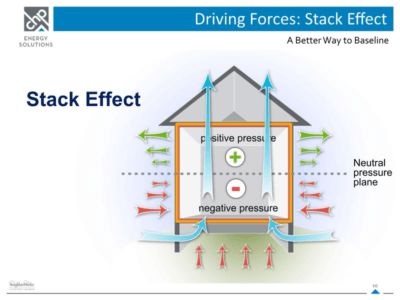
Brrr.. Why the house so cold?
In Alaska, we should have warm, cozy homes that don’t cost an arm and a leg to heat! Homes that don’t feel drafty like a sea breeze on the beach in Homer or be as dry as the Arizona desert during the cold months!
Unfortunately, we don’t build energy efficient homes, unless the builder decides to construct a Five Star Energy rated home, or we do it ourselves after the home is already built.
We rely on big heating systems to overwhelm the deficiencies in the home’s construction, making Enstar the happy utility company in Anchorage.
Cold, dry air enters our homes through all the little air leaks throughout the home’s structure below the neutral pressure plane.
Below the neutral pressure plane – the warm, heated, moist air escapes through the other air leaks above the neutral pressure plane. Normally, 30 percent of the cold air enters the home through the crawlspace or foundation and 15 percent of the heated air escapes through the roof.
Most crawlspaces are semi conditioned areas, minimal heat is maintained to keep the foundation and plumbing lines from freezing. We allow lots of cold, fresh air to flow through the crawlspace via the joist vents (located along the foundation) to expel soil gasses and help prevent wood rot caused by fungi growth.
Even with these vents closed in winter, a tremendous amount of outside air will still enter the home via the other leaks along the sill plates, floor joists and wall framing of the home. Causing the cold air to pass up into the living spaces (i.e. where you watch TV or have dinner).
Not the smartest way to build a home, right? But it’s unfortunately the building standard here in Alaska.
What can you do about all the cold air entering your home?
We can reduce the cold drafts by air sealing every leak along the foundation footings, sill plates, siding joints and seams below the interior finished floor.
And we can seal off all the plumbing, electrical penetration and framing joints from the crawlspace. This will help reduce the amount of cold air entering the home and reduce the pressure causing cold air to flow between the crawlspace and the living space.
Here is what you can do to have a conditioned crawlspace that falls along the lines of an energy efficient home!
- Install a small exhaust fan in the crawlspace, attached to the building exterior, to help expel moisture and soil gasses.
- Confirm the soil vapor barrier is in good condition – seal at all joints, seams and foundation footings.
- Add extra insulation, as a passive heating solution, to help maximize the home’s heating efforts.
This will help to turn the crawlspace from a semi conditioned, naturally, ventilated crawlspace into a conditioned, mechanically, ventilated crawlspace –reducing your Enstar bill, the cold drafts on the back of your neck AND reduce carbon footprint of your home for that save-the-planet peace of mind!
There are other air leaks present in our homes that can be addressed but the best starting point and biggest bang for your buck in south central Alaska is to insulate that dusty crawlspace!
Note: This is an abbreviated blog designed to get you moving in the right direction. All upgrades to your existing home should be reviewed by a licensed professional, such as a General Contractor, who is trained in energy efficient upgrades, an AHFC Energy Rater or other design professional.




